Beneficial
tumblebug
Family: Scarabaeidae Subfamily: Scarabaeinae Genus: Canthon Species: Canthon viridis (Beauvois, 1805)
none available
Total body length 2.0–4.0 mm (0.08–0.16 in). Body shape round (dorsal view); may be caked in dried dung. Color metallic shining green, sometimes metallic coppery red. Eyes crescent shaped, longer than wide. Clypeusclypeus:
part of the head anterior to the frons; the most anterior portion in dorsal view
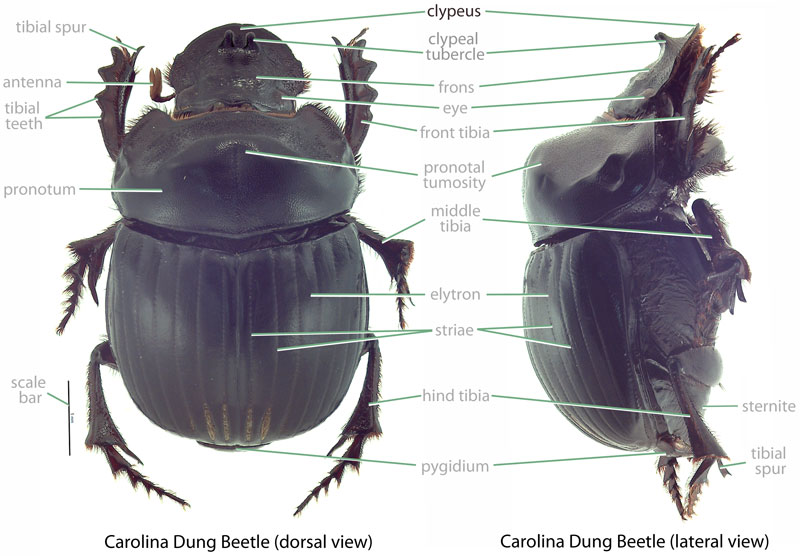 bidentatebidentate:
bidentatebidentate:
a surface that is sharply notched, usually resulting in two tooth-like protrusions on each side of the notch
; surface smooth. Pronotumpronotum:
the dorsal surface of the thorax
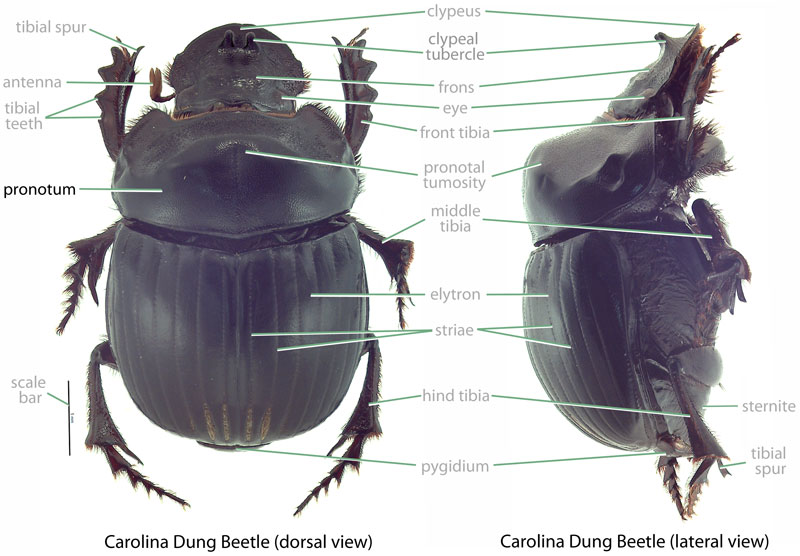 and elytraelytra:
and elytraelytra:
the hardened and chitinous wing-cover of a beetle that protect and overlie the flight wing
smooth, lacking coarse granular texture. Front tibiatibia:
a segment of the leg articulated with the tarsus and femur
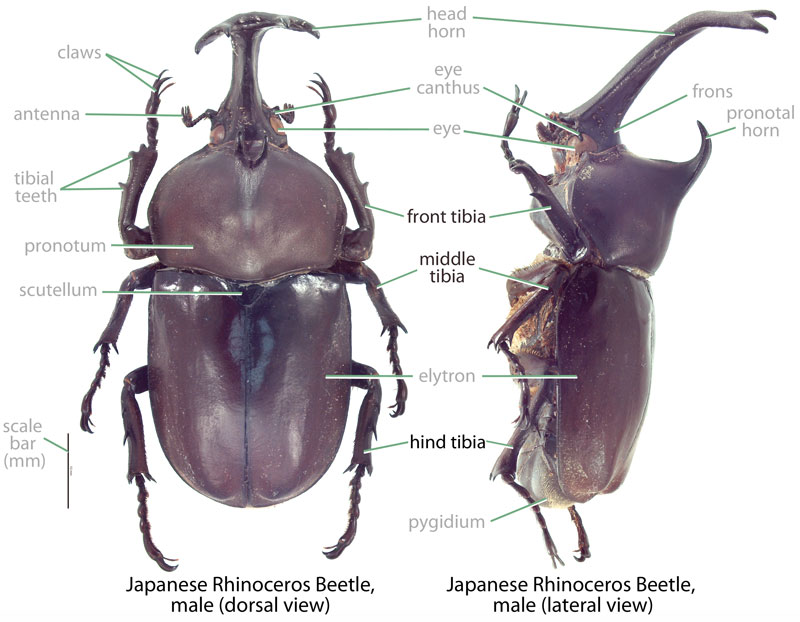 with apical spurspur:
with apical spurspur:
movable, spine-like process, sometimes mobile, often found at or near the tibial apices
 bifurcatebifurcate:
bifurcatebifurcate:
a process dividing into two points
in male and spine-like in female (spur may be worn down in older individuals). Middle and hind legs elongate. Pygidiumpygidium:
the last abdominal segment, usually exposed, not completely covered by the elytra
 width less than twice the height.
width less than twice the height.
(Blume, 1981Blume, 1981:
Blume R. 1981. Glaphyrocanthon viridis viridis (Beauvois): description of larva and notes on biology (Coleoptera : Scarabaeidae). The Coleopterists Bulletin 35: 235-238. full text (accessed 2015)): Grub C-shaped, hump-backed, cylindrical, whitish. Anal slit transversetransverse:
extending horizontally across a surface
. Chaetopariachaetoparia:
inner, bristle-covered portion of the paria
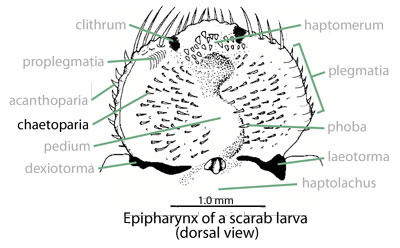 with 4–5 setaesetae:
with 4–5 setaesetae:
small, hair-like structure
. Maxillary stridulatory area with 8–10 teeth. Prothoracic shieldprothoracic shield:
the chitinous plate behind the head of larvae
 without anterioranterior:
without anterioranterior:
the front or forward; opposite of posterior
projecting, angular process on each side. Legs each with a single long, terminal setaseta:
small, hair-like structure
surrounded by 5–6 short setae; 2-segmented; without stridulatory structures; claws absent. Venter of last abdominal segment with single, broad, caudalcaudal:
oriented towards the posterior
, median lobe; median lobe with 2 inconspicuous patches of very short setaesetae:
small, hair-like structure
.
Eastern North America. This species is widespread across much of eastern North America, occupying nearly all of the area east of the Rocky Mountains and south of the boreal forest (Woodruff, 1973Woodruff, 1973:
Woodruff R. 1973. The scarab beetles of Florida (Coleoptera: Scarabaeidae) part I. The Laparosticti (Subfamilies: Scarabaeinae, Aphodiinae, Hybosorinae, Ochodaeinae, Geotrupinae, Acanthocerinae). Arthropods of Florida and Neighboring Land Areas 8: 1-220.).
None. This species feeds on dung as both an adult and larvalarva:
the immature form of an insect; in scarabs, also called grub or white grub; preceded by the egg stage, followed by the pupal stage
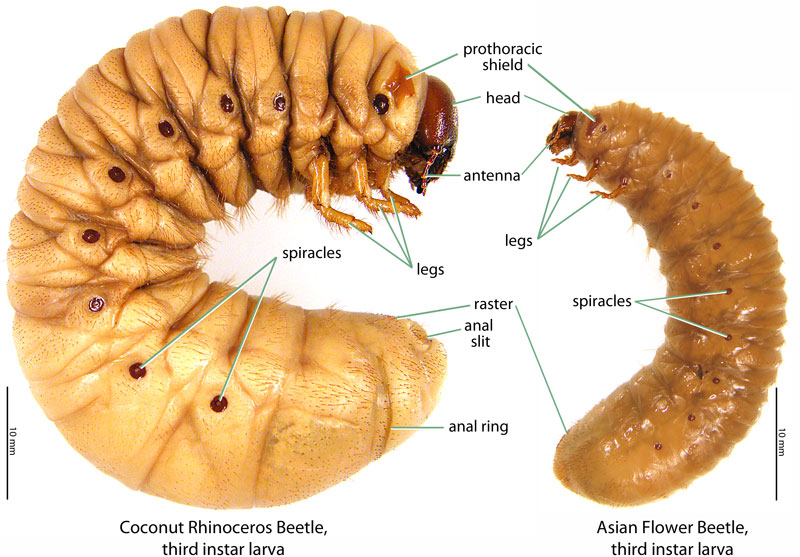 (Woodruff, 1973Woodruff, 1973:
(Woodruff, 1973Woodruff, 1973:
Woodruff R. 1973. The scarab beetles of Florida (Coleoptera: Scarabaeidae) part I. The Laparosticti (Subfamilies: Scarabaeinae, Aphodiinae, Hybosorinae, Ochodaeinae, Geotrupinae, Acanthocerinae). Arthropods of Florida and Neighboring Land Areas 8: 1-220.).
(Blume, 1981Blume, 1981:
Blume R. 1981. Glaphyrocanthon viridis viridis (Beauvois): description of larva and notes on biology (Coleoptera : Scarabaeidae). The Coleopterists Bulletin 35: 235-238. full text (accessed 2015)): In Texas, adults of this species are active April through June. Adults are dung rollers, laying an egg within an ovate-shaped piece of dung. The formed dung is rolled away from the fecal pile before being buried in soil 3–6 cm (1.1–2.5 in) below the surface. LarvaeLarvae:
the immature form of an insect; in scarabs, also called grub or white grub; preceded by the egg stage, followed by the pupal stage
 emerge from eggs 24–36 hours after being laid, and the larvalarva:
emerge from eggs 24–36 hours after being laid, and the larvalarva:
the immature form of an insect; in scarabs, also called grub or white grub; preceded by the egg stage, followed by the pupal stage
 feeds upon the dung. An average of five days is spent in the combined first and second instars, with the final instarinstar:
feeds upon the dung. An average of five days is spent in the combined first and second instars, with the final instarinstar:
in scarabs, one of the three larval growth phases (i.e., first instar, second instar, third instar), each ending with the larvae molting to the next phase
lasting 9–10 days. The pupal stage lasts an average of 3 days. Canthon viridis is diurnaldiurnal:
active during daylight hours
and is largely confined to woodland areas where it has been recorded feeding on the dung of rabbits, humans, swine, cattle, and birds (Ratcliffe and Paulsen, 2008Ratcliffe and Paulsen, 2008:
Ratcliffe B and Paulsen P. 2008. The scarabaeoid beetles of Nebraska (Coleoptera: Scarabaeoidea). Bulletin of the University of Nebraska 22: 138-248.).
None. This species recycles dung and is beneficial for ranching and farming in Hawaii. As an obligate dung feeder, this species poses no threat to crop or ornamental plants. Additionally, this species is not a threat to native dung beetles because none occur in Hawaii or Guam.
Not established. This species was intentionally released in 1954 at Parker Ranch on Big Island (Weber, 1955Weber, 1955:
Weber P. 1955. Recent introductions for biological control in Hawaii—1. Proceedings of the Hawaiian Entomological Society 16: 162-164. full text (accessed 2015)). Similar dung beetle introductions were undertaken to help control populations of the horn fly (Haematobia irritans), a biting pest of livestock (Markin and Yoshioka, 1998Markin and Yoshioka, 1998:
Markin G and Yoshioka E. 1998. Biological control of the horn fly, Haematobia irritans L., in Hawai'i (Diptera: Muscidae). Proceedings of the Hawaiian Entomological Society 33: 43-50. full text (accessed 2015)). Despite this effort, Canthon viridis failed to establish populations in the state (Nishida, 2002Nishida, 2002:
Nishida G (editor). 2002. Hawaiian terrestrial arthropod checklist, fourth edition. Bishop Museum Technical Report 22: 1-313.).
Not established or recorded. There are no records of this species from Guam.
In Hawaii, this species was intentionally released but it did not establish.
This scarab is one of four Canthon species recorded from Hawaii (none are known from Guam). It is distinguished from the other Canthon species recorded in Hawaii by examination of the pronotal texture (texture smooth in C. viridis versus coarsely granulategranulate:
relating to a coarse, grainy surface texture
in C. pilularius), color (shining green or red in C. viridis versus dark blue-black in C. humectus, dark metallic green in C. indigaceus, velvety black to green in C. pilularius), size (2.0–4.0 mm [0.08–0.16 in] in C. viridis versus from 8.0-17.0 mm [0.31-0.67 in] in the other Canthon species), and pygidiumpygidium:
the last abdominal segment, usually exposed, not completely covered by the elytra
 shape (pygidium width less than twice the height in C. viridis versus width more than twice the height in C. humectus).
shape (pygidium width less than twice the height in C. viridis versus width more than twice the height in C. humectus).
Ateuchus obsoletus Say, Canthon metallicus Sturm, Canthon viride Beauvois, Canthon viridulus Dejean, Copris viridis Beauvois, Glaphyrocanthon viridis (Beauvois), Onthophagus viridicatus Say
Report your observation of this beneficial species at our iNaturalist project.